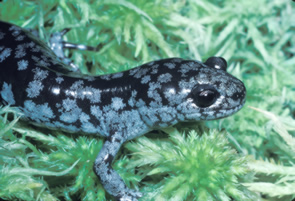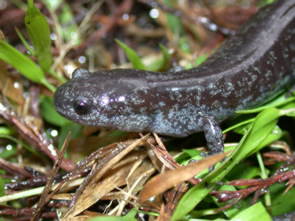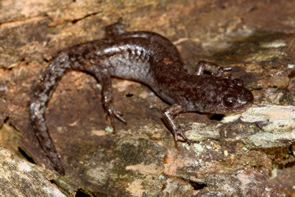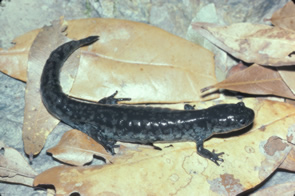
Ambystoma mabeei
Photo by D Dennis
Description: The Mabee’s salamander is a slender brown or black salamander with a brown or grey belly. Its sides are heavily speckled with flecks of white. Unlike flatwoods salamanders (Ambystoma cingulatum), Mabee’s salamander has fewer and duller speckles on its back and only a single row of jaw teeth. It can be differentiated from the stocky mole salamander (Ambystoma talpoideum) by its small head and long toes. This species may also be confused with the Slimy Salamander (Plethodon glutinosus), a black species which has a groove between its nose and lip. The aquatic larvae have broad dorsal fins. At hatching, the larvae have a yellow stripe on each lateral flank and a more uniform brown coloring than adults. As they mature, they develop two indistinct cream-colored stripes in place of the single stripe. The dorsal fins of mature larvae are molted with black spots. In contrast to flatwoods salamander larvae, the lateral stripes of Mabee’s salamander larvae are broken and light. While the flatwoods salamander larvae have eye stripes that are clear and bold, in Mabee’s salamander the eye stripes, if present, are weakly defined.
Habitat/range: This species only occurs in North America and ranges from southern Canada south to Mexico City. In North Carolina, Mabee’s salamanders occupy the savanna pine barrens in the eastern coastal plain. They typically spend their adult life in soil near bogs, ponds, and swamps. Some disperse away from breeding sites to meadows or nearby forests while other remain near their larval habitat even after it has dried up, living in the cover of leaves and pine needles on the dried mud.
Diet: Larvae and adults feed on zooplankton and invertebrates.
Reproduction: Breeding takes place from late fall to early spring, usually occurring after the flatwoods salamanders’ breeding season. The height of breeding season is in the winter or early spring during heavy warm rains. The females lay their eggs on the vegetation or detritus of ephemeral or shallow, still water without fish. The females may deposit eggs singly or in short chains of two to six. The eggs hatch in nine to fourteen days. The larvae will emerge from ponds as adults after only a few months.

The shaded region represents the range of Mabee's salamander in North Carolina.


 - PH.jpg)
Photo by JD Willson


Photo by Ed Corey
Photo by D Dennis
